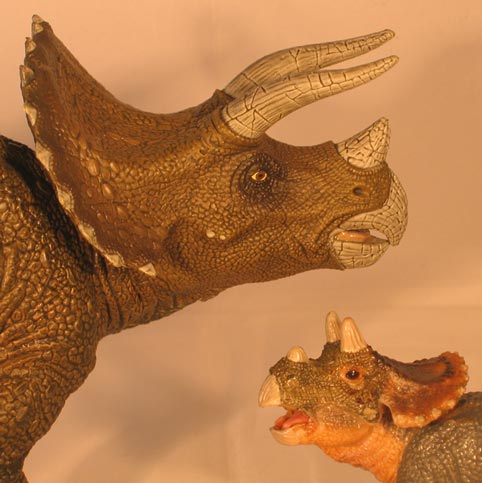Is the Triceratops genus Threatened?
Triceratops versus Torosaurus Debate – Does this mean the end of Trike?
With the publication of the controversial theory that Triceratops was not actually a distinct dinosaur genus but a younger version of Torosaurus, fears have been raised about the name Triceratops going the same way as Brontosaurus. For many dinosaur fans, the thought of losing Triceratops from the scientific record of genera is a little hard to take. The media has jumped onto this story and fuelled the flames and a number of articles have been published, many of them factually incorrect.
Triceratops
On the basis of the study carried out so far, it is unlikely that Triceratops, an iconic dinosaur and one of the most popular dinosaurs in our annual Everything Dinosaur survey will be erased. Triceratops or “Trike” as it is sometimes known was a horned dinosaur (name means “three horned face”), that lived at the very end of the Age of Reptiles. A member of the Chasmosaurinae, Triceratops has two species ascribed to the genus, but the trouble is, these dinosaurs as they grew changed and this has led to much confusion over the interpretation of the fossil material.
The skulls of Triceratops were massive and a number of fine specimens have been discovered. Over the years since Triceratops was first described (1888), so many different skulls of Triceratops have been unearthed that at one time sixteen species had been ascribed to the genus. Following extensive revision, most palaeontologists accept that there are just to species. However, following work from a team of American palaeontologists and researchers a theory has been put forward that Triceratops fossils actually represent younger versions of another large, horned dinosaur – Torosaurus.
A Model of the Head of “Three Horned Face” (Triceratops)

The baby Triceratops figure next to the adult Papo Triceratops. Picture credit: Everything Dinosaur.
Picture credit: Everything Dinosaur
To view a model of Triceratops and other dinosaur toys: Papo Dinosaur and Prehistoric Animal Models.
As these animals grew and matured so the shape of their distinctive skulls and crests changed. The study of animal growth rates is called ontogeny, and given the paucity of the fossil record, interpretation of fossil material is exceptionally difficult. In the scientific publication “The Journal of Vertebrate Palaeontology” two palaeontologists John (Jack) Horner and John Scannella published their findings after undertaking an extensive analysis of the morphology of Triceratops and Torosaurus skulls.
Comparing Skulls
To read more about this topic: The Extinction of Torosaurus – Second Time Around.
However, dinosaur experts are trying to make it clear to the media that they are not in the business of removing Triceratops from the history of the Dinosauria. It had been thought that Torosaurus was a very close relative of Triceratops but it did have generally a larger skull and longer neck crest with two distinctive holes in it, whilst Triceratop’s head crest was made of solid bone. In the study by the American team it seems that as Triceratops got older so the neck crest got thinner and two holes (called fenestrae) began to appear. The holes would have been covered in skin when the animal was alive and probably served as signalling device amongst herd members, with the fenestrae making the skull lighter.
Commenting on his work, Horner stated:
“When we examined it [Triceratops skull] and actually looked at how the bone grows, we could see that the frill starts out solid, and as it gets bigger and bigger it becomes thinner and thinner until there’s holes in the middle of it.”
The American scientists accept their theory may be controversial but they do want to make one important point. Since in science it is the animal name first used that takes precedence, Triceratops is not in danger of becoming extinct for a second time.
“Triceratops was named before Torosaurus so it has precedence. But a lot of people in the press didn’t know that so they thought this meant that Triceratops was going to go away, and it is not.”
Dr Horner concluded
As curator of palaeontology at the Museum of the Rockies, Dr Horner and his team have been responsible for the naming and describing of a number of dinosaurs and prehistoric animals – including the duck-billed dinosaur Maiasaura, “Good Mother Lizard”. This member of the Hadrosaurine is associated with an amazing fossil site in Montana (United States), the remains of a dinosaur nesting colony.
To view models of hadrosaurs like Maiasaura: CollectA Age of Dinosaurs Prehistoric Life Models.
Rare Torosaurus
In comparison to Triceratops, very few Torosaurus fossils have been found. This would make sense if Torosaurus actually represented elderly versions of Triceratops as only a small number of these herbivores would have made it to old age. In addition, and perhaps most significantly, no fossils of juvenile Torosaurs have been found to date. This fact adds credence to the theory of Triceratops being younger versions of Torosaurus as proposed by the two American scientists.

